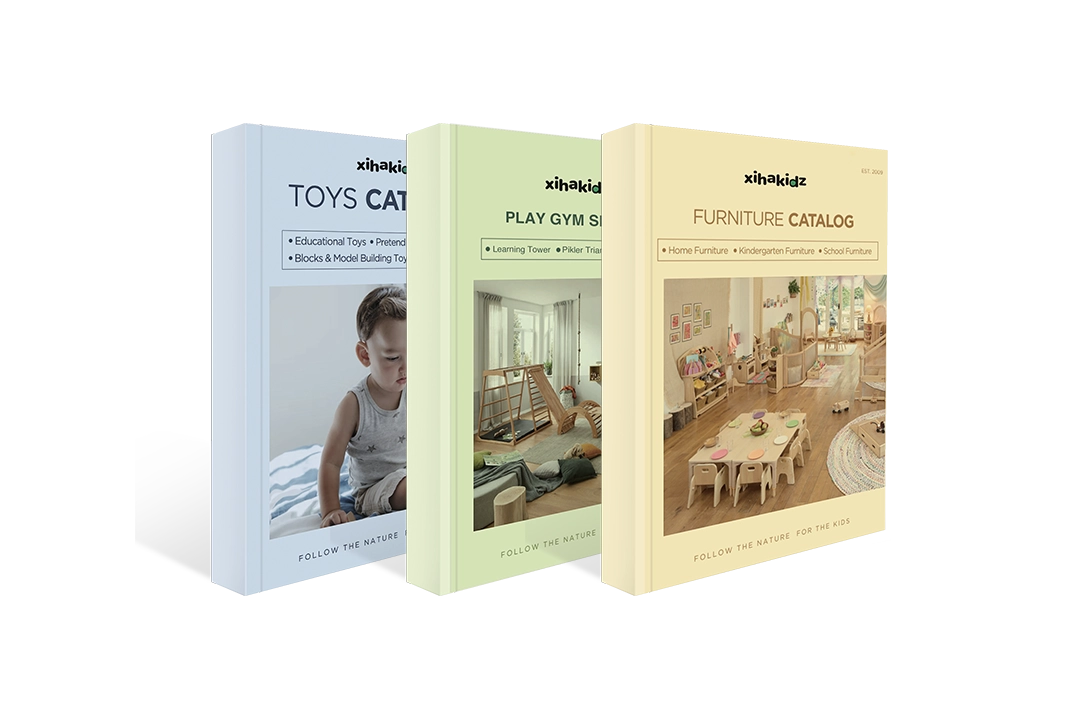Durable and Safe Changing Tables for Preschools and Daycare Centers
Our changing tables are designed with functionality and safety in mind, ensuring a comfortable and secure environment for children. Crafted with premium materials, these tables prioritize child safety and hygiene while offering ample storage for essentials. With our furniture customization service, you can tailor the changing table to fit your specific space and aesthetic requirements.

Comprehensive Range of Changing Tables
Our diverse collection of changing tables is tailored to meet the unique requirements of preschools, daycares, and home environments. Choose from various designs, including compact, wall-mounted, and freestanding models, each crafted for durability and safety. Whether you're looking for robust storage options, ease of access, or compact designs, our versatile collection ensures you find the perfect match for your environment.
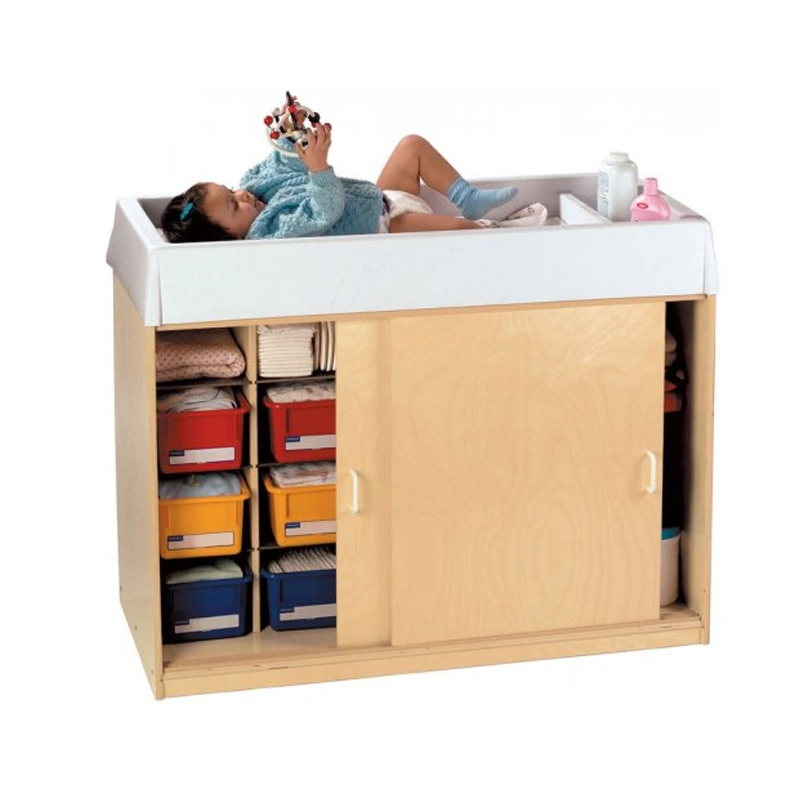
Changing Station with Easy Wash Top

Changing Station With Hand Washing Sink

Changing Table With Stairs
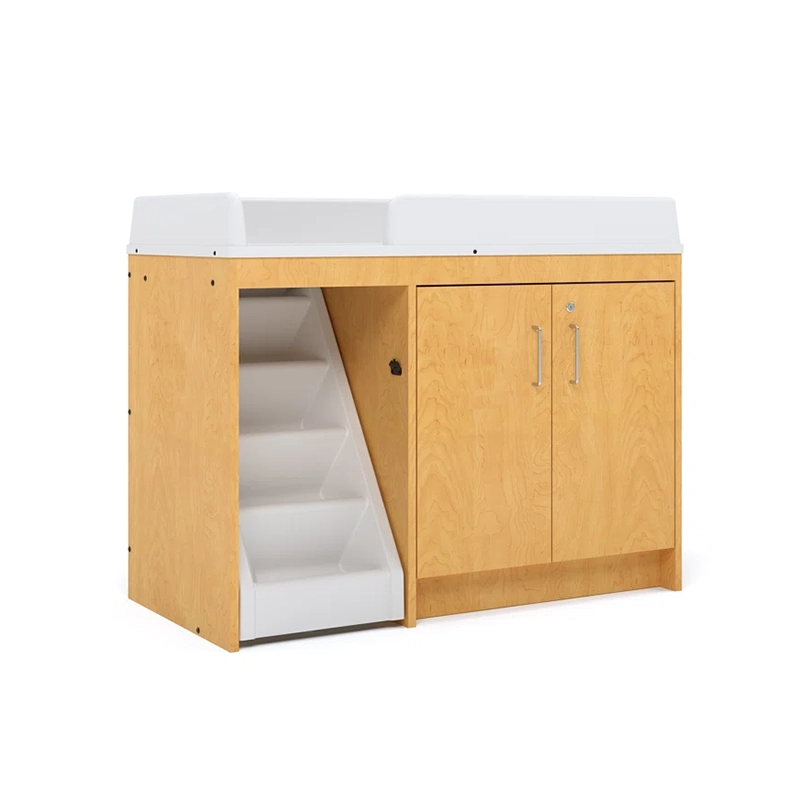
Toddler Walkup Changing Table
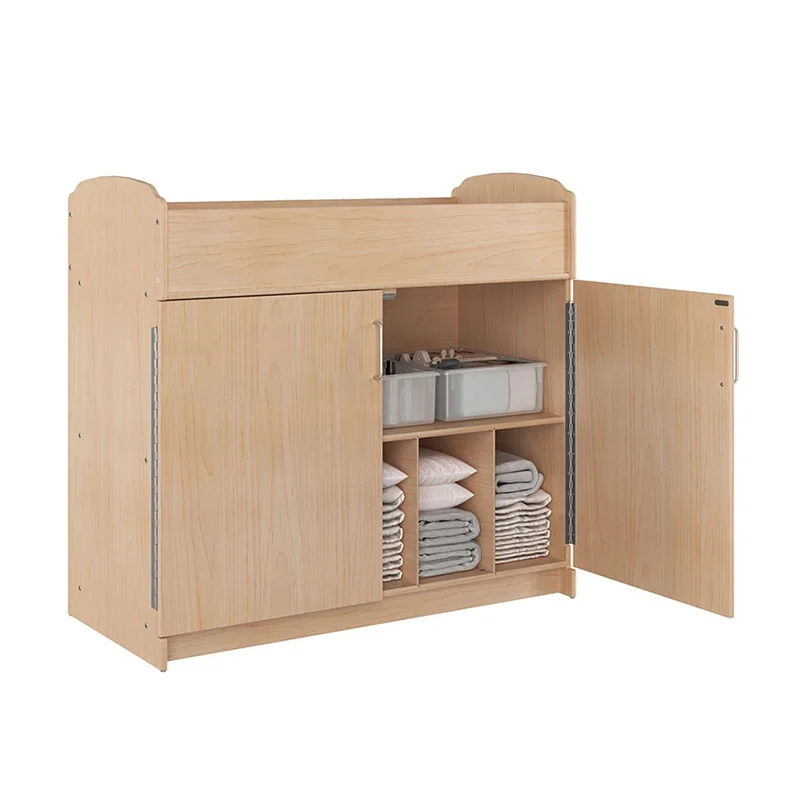
Changing Table With Storage

Wall Mounted Diaper Organizer
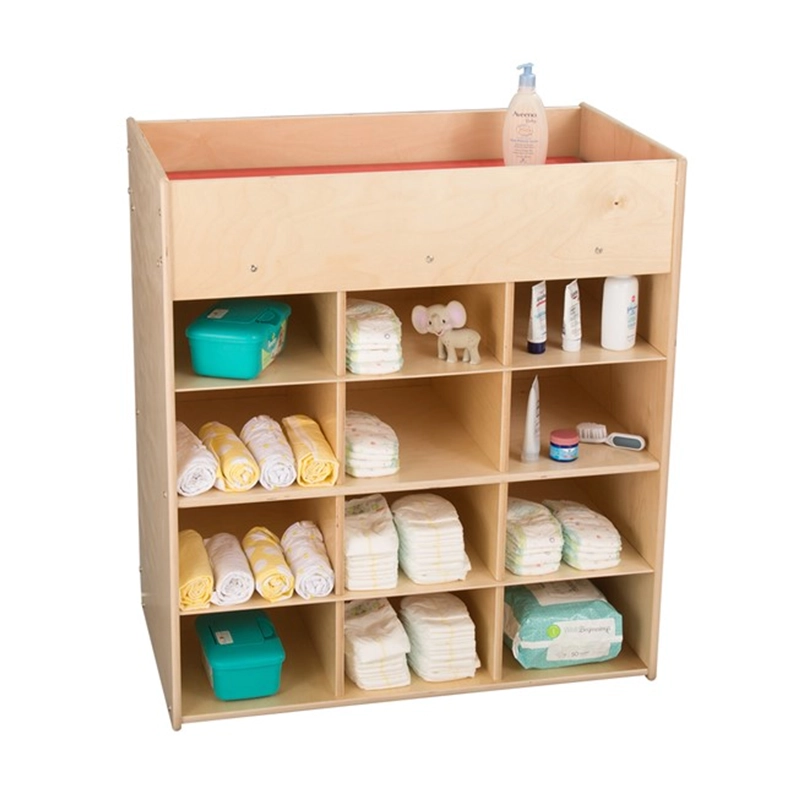
Economy Daycare Changing Station

Changing Table with 2 Shelves

Modern Convertible Changing Table

Baby Changing Table With Toys

Changing Station with Wheels

Vertical Surface Changing Station
Trusted Manufacturer of Changing Tables
With over 20 years of educational product expertise, we have built a reputation for reliability and innovation. Our dedication to quality and customer satisfaction is evident in every product we design and manufacture. By delivering solutions that seamlessly combine safety, functionality, and style, we have become a trusted partner for childcare providers worldwide.
Our diaper-changing stations are thoughtfully crafted to meet the needs of both caregivers and children. Made from premium, eco-friendly materials, they create a secure, hygienic, sustainable environment supporting modern childcare settings. With features such as impact-resistant surfaces, adjustable safety straps, and ergonomic designs, our stations prioritize safety and caregiver comfort.
We adhere to the highest safety and quality standards, meeting and exceeding ASTM, EN, and CPSC certifications. Rigorous quality control at every production stage ensures durable, reliable products that stand the test of time. Our diaper-changing stations are a testament to our commitment to excellence in design, engineering, and childcare innovation.
Optional Changing Table Materials
Please select from our variety of high-quality changing table materials. Our materials are chosen to ensure safety and functionality, helping you create a comfortable and nurturing space for your baby. Customize your changing table to integrate perfectly with your daycare center’s decor and specific preferences.

Solid wood changing tables are durable and sturdy. Popular wood types include pine, oak, and walnut. They offer a warm, natural aesthetic but tend to be more expensive.

Metal changing tables are highly durable and easy to clean. Common metals used include aluminum and stainless steel. They offer a modern look and fit well in contemporary decor settings.

Durable, colorful, laminated MDF is used for kitchen counters and play surfaces. Its smooth finish resists wear and tear and is easy to clean, making it ideal for messy play areas.

Lightweight and colorful, plastic is ideal for small items like toy carts and pretend food. It’s durable, easy to handle, and simple to clean, making it perfect for constant use in play.
Types of Changing Tables
Changing tables come in various types, from classic standalone designs to versatile dresser combos and space-saving wall-mounted options. Each type caters to different needs, spaces, and lifestyles, ensuring a perfect fit for every caregiver.

Classic Changing Table
A freestanding unit designed explicitly for diaper changes, featuring a sturdy, flat surface with safety rails and ample storage underneath. These tables often come with shelves or drawers to keep diapers, wipes, and clothes organized, which is a practical choice for preschool.

Wall-Mounted Changing Table
Wall-mounted changing tables are compact, foldable units that attach to the wall, saving valuable floor space. Perfect for smaller homes or public restrooms, they offer a sleek and modern solution but usually come with minimal storage options and require proper installation for safety.
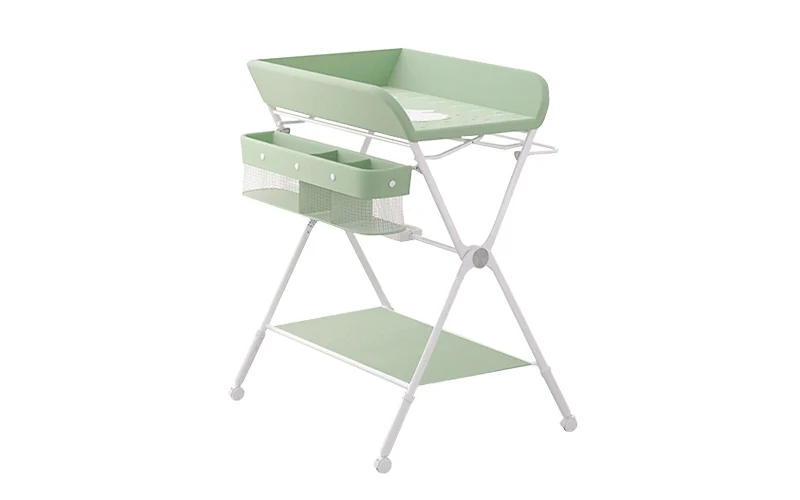
Portable Changing Tables
Portable changing tables are lightweight, portable options that can be folded flat for easy storage or travel. These tables are ideal for families on the go, providing a simple and space-saving solution, though they may lack larger models' durability and storage capacity.
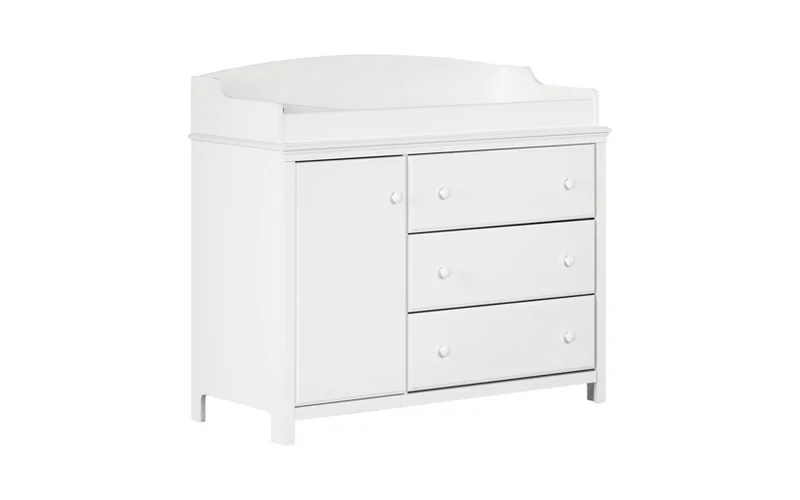
Changing Table Dresser
A dresser changing table offers a safe diaper-changing space with built-in storage for essentials like diapers and wipes. It is practical and versatile and transitions into a regular dresser as your child grows, making it a brilliant nursery addition.
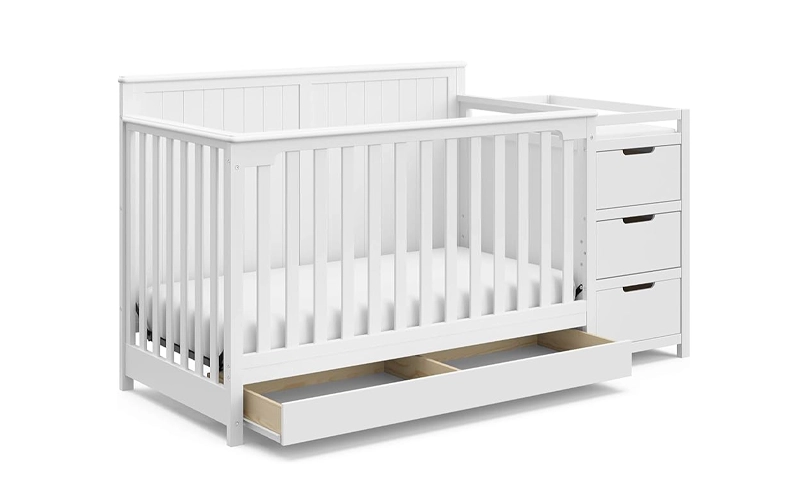
Changing Table and Crib Combos
Changing table and crib combos integrate a crib with an attached changing surface, offering a 2-in-1 solution for small spaces. This design includes storage compartments for diapering essentials and maximizes functionality within a limited footprint, though its usability is tied to the crib's lifespan.

Corner Changing Table
Corner changing tables are uniquely designed to fit snugly into a room's corner, optimizing space in smaller nurseries. With a triangular surface and often multiple shelves underneath, these tables provide ergonomic access for parents while efficiently using every inch.

Movable Changing Table
Movable changing tables are equipped with wheels or casters, allowing easy relocation throughout the home. These tables combine mobility with practicality, featuring storage space for essentials, but may require locking mechanisms to ensure safety during use.
Choose the Right Changing Table
Choosing the right changing table is essential for ensuring the safety and comfort of your baby during diaper changes. Let's delve into the details to make an informed decision.
Safety Features
Safety should be your top priority. Look for a table with high sides to prevent your baby from rolling off. Ensure it has a sturdy construction that doesn't wobble and includes safety straps or a harness. Check for certifications that guarantee the table meets current safety standards.
Storage and Organization
Consider changing tables with built-in storage options such as shelves, drawers, or baskets. These can help keep all the necessary changing supplies (like diapers, wipes, and clothes) within easy reach. An organized changing station can make diaper changes quicker and less stressful.
Size and Fit
Make sure the changing table fits well in the nursery or the room where you'll be using it, Compare them to your available space. Also, consider the height of the table. It should be at a comfortable height so you won't have to bend over excessively, which can cause back strain.
Material and Cleanliness
Changing tables come in various materials, including wood, plastic, and metal. Choose a material that not only complements your nursery’s decor but is also easy to clean. Surfaces should be non-porous to prevent absorption of liquids and easy to wipe down after each use.
Versatility and Longevity
Some changing tables can be converted into dressers or storage units after the baby outgrows them. Consider these convertible options for better long-term value. Check if the table can adapt to different stages of your child’s growth or be repurposed for other uses in your home.
Budget Considerations
Determine how much you are willing to spend before you start shopping. Keep in mind that higher prices often correlate with better materials and more features. However, it's important to balance cost with the essential features you need for safety and convenience.
The necessity of using a changing table
Safety
Changing tables are designed with safety in mind, featuring raised edges and safety straps to secure the baby. This reduces the risk of falls, providing peace of mind during diaper changes.
Comfort
The ergonomic height of changing tables helps prevent back pain for caregivers, making diaper changes more comfortable without the need to constantly bend over.
Aesthetics
Available in various styles and finishes, changing tables can complement your nursery’s decor, adding functional elegance to the space.
Hygiene
Provide a variety of props, such as costumes, toy tools, and pretend food, to support diverse role-play scenarios. Rotating props regularly keeps the area exciting and inspires fresh, imaginative play.
Convenience
A designated changing station establishes a consistent routine, making diaper changes quicker and less disruptive, especially during the night.
Organization
Equipped with shelves or drawers, changing tables keep all necessary supplies like diapers, wipes, and creams within easy reach, ensuring an organized and efficient diapering process.
One-Stop Solution
Our One-Stop Solution is designed to provide a seamless, stress-free experience for preschool and wholesalers of children's furniture and toys. We manage the entire process from product design to delivery, so you can focus on growing your business while we handle the details. Here’s how our One-Stop Solution works:
Request Your Personalized Solution!
The Best Size of a Changing Table
The ideal size of changing tables depends on available space, user comfort, and storage needs. However, most standard changing tables are designed with the following dimensions:
Standard Dimensions
- Length: Generally, changing tables are about 36 to 40 inches long. This length provides enough space to accommodate a baby comfortably.
- Width: The width of changing tables usually ranges from 18 to 22 inches. This width is sufficient to change a baby safely while ensuring the table doesn’t take up too much space.
- Height: The height of changing tables typically ranges from 34 to 40 inches. A height within this range is ideal for most adults to change a baby without bending too much, which can help prevent back pain.
Custom Dimensions
Our custom-changing tables are perfect for those with unique spaces or specific requirements. Whether you’re designing a compact nursery or a large daycare, custom sizes ensure a precise fit that maximizes functionality and storage.
Key Safety Design Features for Changing Tables
Ensuring your baby’s safety during every diaper change starts with a well-designed changing table. The right features provide stability and security and create a comfortable and stress-free experience for parents and little ones.
Stable Construction
The changing table must have a sturdy and durable construction to prevent tipping or wobbling during use. It should be built with high-quality materials that can support the weight of a baby securely throughout its use.
Raised Edges
High sides or barriers are essential to prevent infants from rolling off the table. These edges should be at least 2 inches high to provide an effective containment area while changing diapers or clothes.
Safety Straps
A safety strap with a buckle helps secure the baby on the table, providing an additional layer of safety. The strap should be adjustable to fit securely around the baby without causing discomfort.
Non-Skid Feet
The legs of the changing table should be equipped with non-skid pads to prevent the table from sliding on smooth surfaces. This feature is crucial for maintaining stability and safety.
Contoured Changing Pad
A contoured pad with raised sides offers additional security by helping to keep the baby centered on the changing table.
Accessible Storage
Storage areas for essential items like diapers, wipes, and clothes should be easily accessible without having to leave the baby unattended. Ideally, these should be reachable with one hand while the other secures the baby.
Locking Mechanism
If the changing table is foldable or has moving parts, a reliable locking mechanism is vital to ensure it stays in place during use and does not collapse or fold unexpectedly.
Smooth Corners and Edges
All corners and edges should be rounded and smooth to prevent injuries from sharp corners. This design consideration is crucial to avoid any accidental scratches or harm to both the baby and caregiver.
Essential Supplies for a Baby Changing Table
Equipping a baby changing table with the right supplies for any nursery or childcare facility is crucial for efficient and safe care. The proper setup can make all the difference from must-have essentials like diapers and wipes to comfort-enhancing extras.

Diapers
Provide a range of diaper sizes to accommodate infants of different ages, including newborn and larger sizes.

Baby Wipes
Stock hypoallergenic and fragrance-free baby wipes for sensitive skin, ideal for cleaning the infant without irritating.

Changing Pad
Offer both washable and disposable changing pads that are waterproof, making them easy to clean and replace as needed.

Diaper Pail
Include a diaper pail with a tight-sealing lid to contain odors and a foot pedal for hands-free operation to maintain hygiene.

Skin Care Products
Provide baby skincare products such as diaper rash cream to prevent and treat irritation and a gentle moisturizing lotion for daily skin care.

Disposable Bags
Have small disposable bags on hand for discarding used diapers. These should be easy to tie and strong enough to prevent leaks.

Spare Clothes
Keep a stock of clean baby clothes and diaper covers at the changing station, to ensure a quick change in case of accidents.

Hand Sanitizer
Place an alcohol-based hand sanitizer near the changing area for caregivers to use before and after each diaper change.
Cleaning and Maintenance Tips for Your Changing Table
A clean and well-maintained changing table is essential for your baby’s safety and hygiene. Proper care not only ensures a germ-free environment but also extends the life of your furniture. Neglecting cleaning routines or maintenance can lead to unpleasant odors, stains, and even safety concerns over time.
Daily Cleaning Practices
- Wipe Down After Each Use: Use baby-safe disinfectant wipes or a mild soap solution to clean the surface after every diaper change. This prevents the buildup of germs and stains.
- Focus on High-Contact Areas: Pay special attention to safety straps, guardrails, and any textured surfaces where dirt can accumulate.
Weekly Deep Cleaning
- Remove and Wash Covers or Pads: If your changing pad has a removable cover, wash it weekly using a baby-safe detergent.
- Inspect for Spills and Stains: Check for any residue in crevices or drawers and clean with a soft brush or cloth.
- Sanitize Hard Surfaces: Use a non-toxic cleaner to disinfect the table thoroughly, ensuring no harmful residues are left behind.


Periodic Maintenance
- Check for Loose Hardware: Inspect screws, bolts, and fasteners monthly to ensure the table remains sturdy and secure.
- Examine for Wear and Tear: Look for cracks, chipped paint, or broken edges that may pose safety hazards and address them promptly.
- Protect Wooden Surfaces: If your table is wooden, occasionally apply a safe wood polish to keep the surface smooth and prevent damage.
Avoiding Common Cleaning Mistakes
- Avoid Harsh Chemicals: Always use non-toxic, baby-friendly products to clean the table and pad.
- Don’t Skip Drying: After cleaning, ensure all surfaces are thoroughly dried to prevent moisture buildup, which can lead to mold or warping.
FAQ
A clean and well-maintained changing table is essential for your baby’s safety and hygiene. Proper care not only ensures a germ-free environment but also extends the life of your furniture. Neglecting cleaning routines or maintenance can lead to unpleasant odors, stains, and even safety concerns over time.
What is a diaper changing table, and why is it necessary?
A diaper changing table is a dedicated surface designed for safely changing a baby’s diaper. It often includes storage for baby essentials like wipes, diapers, and creams. It helps parents avoid bending over uncomfortably and keeps everything organized.
When should you not use a changing table?
You should stop using a changing table when your child exceeds 24 months of age or weighs more than 30-50 pounds, depending on the table's weight limit. At this stage, toddlers are often too mobile, making diaper changes on an elevated surface unsafe. Additionally, many children start potty training around 18-24 months, reducing the need for a changing table. Always prioritize safety by transitioning to floor changes or other alternatives when your child outgrows the table's recommended age or weight capacity.
How Often Should Changing Tables Be Cleaned?
Changing tables should be cleaned and disinfected after each use to prevent the spread of germs and ensure a hygienic environment for the baby. For high-use areas such as public changing stations in restrooms, cleaning should be performed more frequently throughout the day.
How Many Changing Tables Do You Need in a Classroom?
Most childcare experts recommend one diaper-changing table for every 10 children in diapers. This ratio ensures that staff can change diapers efficiently while maintaining hygiene and minimizing waiting times.
Are diaper changing tables safe for babies?
Yes, diaper changing tables are safe for babies when they meet safety standards set by organizations such as the Consumer Product Safety Commission (CPSC). Features such as high guardrails, safety straps, and a stable base help to ensure the baby's safety. Always keep one hand on the baby while using the table to prevent falls.
How do I keep a diaper changing table clean?
To keep a changing table clean, use a disinfectant or a mixture of soap and water to wipe down all surfaces after each use. Avoid harsh chemicals that could harm the baby’s skin. For wooden changing tables, use cleaners that are safe for wood finishes. Regularly check nooks and crannies for dirt buildup, and clean fabric covers according to the care instructions.







